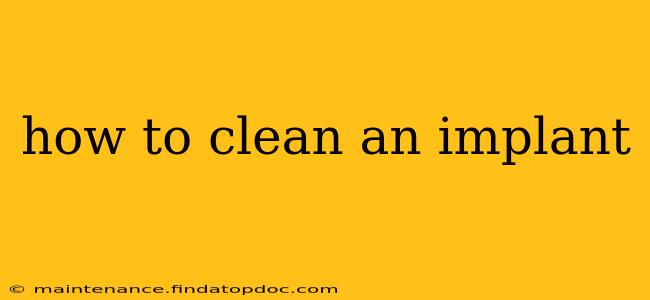Dental implants offer a fantastic solution for missing teeth, providing a secure, natural-looking replacement. However, maintaining their cleanliness is crucial for long-term success and preventing complications. This guide will provide a comprehensive overview of how to effectively clean your dental implant and surrounding areas. Remember, proper oral hygiene is key to preserving your investment and maintaining optimal oral health.
What is a Dental Implant?
Before diving into cleaning techniques, let's briefly revisit what a dental implant is. It's a titanium post surgically placed into the jawbone to act as a root for a replacement tooth (or teeth). This post fuses with the bone over time, providing a strong and stable foundation. The visible part of the implant is a crown, which is attached to the post. Because it's integrated with the bone, cleaning requires a slightly different approach than cleaning natural teeth.
How to Clean a Dental Implant: A Step-by-Step Guide
Cleaning your dental implant effectively involves several key steps:
1. Brushing:
- Use a soft-bristled toothbrush: Harsh bristles can damage the delicate gum tissue around the implant and the crown itself.
- Gentle circular motions: Avoid aggressive scrubbing. Use gentle, circular motions to clean the crown and the surrounding gum line.
- Focus on the gum line: This area is prone to plaque buildup, which can lead to peri-implantitis (inflammation around the implant).
- Fluoride toothpaste: Use a fluoride toothpaste to help strengthen the enamel of any natural teeth you may still have and help prevent cavities.
2. Flossing:
- Use floss threaders: These are particularly useful for accessing tight spaces around the implant and under the crown.
- Gentle movements: Avoid snapping the floss, which can damage the gum tissue. Use gentle, C-shaped movements to clean between the implant and adjacent teeth.
- Interdental brushes: Consider using interdental brushes (small cylindrical brushes) to clean between your teeth and around the implant. Your dentist can recommend appropriate sizes.
3. Interdental Cleaning:
- Water flosser (irrigator): A water flosser can effectively remove food particles and plaque from areas that are difficult to reach with traditional floss.
- Antiseptic mouthwash: After brushing and flossing, use an antiseptic mouthwash to kill bacteria and further reduce plaque buildup. Follow the manufacturer's instructions for proper use.
What are the Best Tools for Cleaning a Dental Implant?
The best tools for cleaning a dental implant are:
- Soft-bristled toothbrush: Choose a brush with soft, rounded bristles specifically designed for sensitive gums.
- Dental floss: Traditional floss or floss threaders, depending on the access needed.
- Interdental brushes: These are crucial for cleaning tight spaces. Your dentist can recommend the correct size.
- Water flosser: This is a great addition to your routine for thorough cleaning.
How Often Should You Clean Your Dental Implant?
You should clean your dental implant at least twice a day, ideally after breakfast and before bed. Maintaining a consistent cleaning routine is crucial for long-term success.
What Happens If You Don't Clean Your Dental Implant Properly?
Neglecting proper oral hygiene around a dental implant can lead to peri-implantitis, an inflammatory condition that can cause bone loss and ultimately implant failure. This condition can be painful and may require extensive treatment.
How Can I Prevent Peri-Implantitis?
Preventing peri-implantitis involves diligent oral hygiene, regular dental checkups, and professional cleaning.
What are the Signs of Peri-Implantitis?
Signs of peri-implantitis include redness, swelling, bleeding, and pain around the implant. If you notice any of these symptoms, consult your dentist immediately.
When Should I See My Dentist After Getting a Dental Implant?
You should schedule regular checkups with your dentist after getting a dental implant. The frequency of visits will depend on your individual needs and risk factors. Your dentist can monitor the health of your implant and make recommendations for maintenance.
This comprehensive guide provides detailed information on how to clean a dental implant. Remember to always follow your dentist’s instructions and maintain consistent oral hygiene to ensure the longevity and health of your implant.
